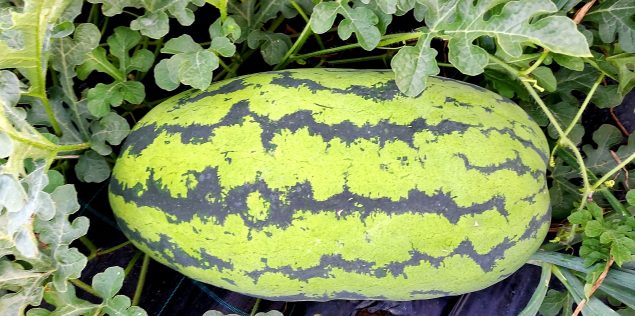Orangeglo Watermelon is thought to have developed in Southern Africa, maybe in the area near Namibia. Since then, watermelons have spread around the world and in the US, have become a favorite food and a representation of summer. Because watermelons thrive in hot temperatures and their frail vines make them extremely sensitive to frost, it is essential to cultivate their seeds only in regions that have extended growing seasons and warm night-time temperatures.
Orangeglo Watermelon is an annual vegetable that grows in warm weather and is very soft. It comes from Texas, where Willhite Seed Company produced and launched it in Poolville in the 1960s. This plant’s mature vines can reach 8 to 10 feet in length and produce 20 to 30-pound watermelons that are spherical, light green, and striped with dark green. In addition to attracting flies and predatory wasps, this plant is safe for rabbits, may be eaten, and is even used in cosmetics and soaps.
Orangeglo Watermelon Taste
The flavor of watermelons with orange and yellow flesh is significantly superior to that of watermelons with red flesh. Watermelons with white flesh taste nice based on the variety. Orangeglo, with its fruity taste, is ranked at the top.
The vines of this type are rather small and seem to be disease-free. The Watermelon Board’s specialists claim that orange and yellow watermelons often have sweeter flesh compared to those with red or pink flesh.
Orangeglo Watermelon Size
The Orangeglo Watermelon, with its fruit that is bright orange-yellow and with a taste that is reminiscent of the tropics, is certain to be an unexpected summertime pleasure. They weigh between 20 and 30 pounds and have green skins that are striped with lighter and darker shades. Even in places with cool weather and short growing seasons, each plant still produces one to three melons.
This particular variety of watermelon is both juicy and crisp, but it is important to remember that mature melons are fragile and should be handled with care. These plants can withstand pest and wilt attacks.
Orangeglo Watermelon Seeds
The characteristic ‘Orangeglo’ seeds are beige and have two brown spots on each of the pointed ends. It is vital to get “Orangeglo” and not another orange watermelon before planting. The following seed characteristics are crucial for Orangeglo Watermelon cultivation:
- 1″ seed depth
- 2 to 5 feet of space between plants.
- 6 feet space between rows.
- Germination Soil Temperature should be 70–80 degrees Fahrenheit.
- 7–10 days for germination.
- It is important to sow inside 4–6 weeks before the last average frost.
- When the average temperature is around 70 degrees Fahrenheit or within three to four weeks after the last frost, seeds are mostly planted outside.
Orangeglo Watermelon Growing
Watermelons called “Orangeglo” are easy to grow. To get strong, vivacious plants with some good roots for planting in the garden, start seeding a couple of weeks well before the typical last frost period for a particular area. During this time, seeds can also be sown directly in the ground.
The best places to grow melons are in hills composed of rich fertilizer and sand, and it is important to cover the area surrounding the plants with black plastic to prevent insect infestations (like borers) and enhance the flavor of the melons. This raises the temperature of the melons, which encourages them to transform more starches into sugars, heats the soil, and helps them retain moisture.
As an additional perk, plastic prevents the crop from touching the earth. The plastic can potentially get too hot and cause the melon’s skin to blister, so t is recommended to place a small straw under each one. Within ninety to hundred days after planting, if they are given excellent soil and plenty of water (to avoid a gritty texture), they are expected to harvest.
Watermelon vines in good health bear two to four fruits per plant. Both female and male flowers are required for fruit production, and female flowers outnumber males by around one to seven.



